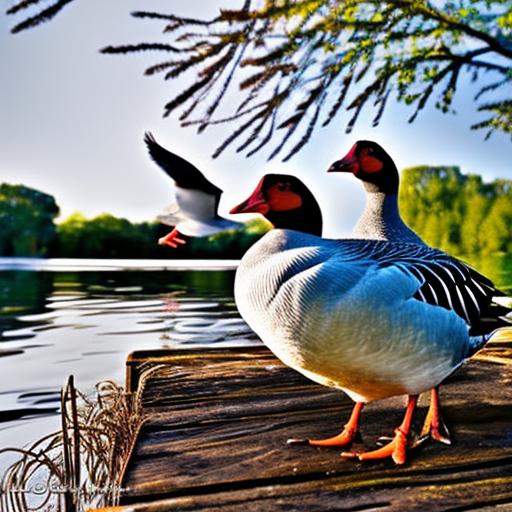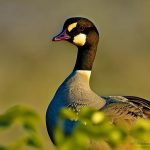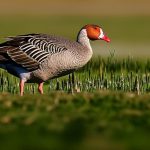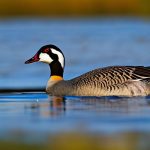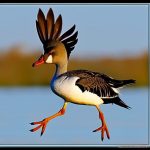Geese are known for their strong migratory instincts and their tendency to return to the same nesting and feeding grounds year after year. They are also highly social animals, often traveling in large flocks. Understanding these behaviors is crucial when it comes to managing geese and preventing them from causing damage to property or posing a threat to human health and safety.
Geese are attracted to areas with ample food sources, open water, and suitable nesting sites. They are also drawn to areas with short grass, making golf courses, parks, and athletic fields prime locations for geese to congregate. Once they have established a presence in an area, geese can be difficult to deter due to their strong homing instincts and territorial nature.
To effectively manage geese, it is important to understand their behavior and use this knowledge to implement appropriate deterrent strategies. By understanding what attracts geese to a particular area and how they behave once they have settled in, property owners and managers can take proactive measures to discourage geese from making themselves at home.
Key Takeaways
- Geese are territorial and can become aggressive, especially during nesting season.
- Physical barriers like fences and netting can effectively prevent geese from entering an area.
- Visual deterrents such as scarecrows and reflective tape can help to keep geese away from a specific area.
- Sound deterrents like ultrasonic devices can be used to deter geese from settling in an area.
- Repellents like taste aversions and chemical deterrents can discourage geese from staying in a particular area.
- Encouraging natural predators like dogs or installing nesting platforms for birds of prey can help control geese populations.
- Regular maintenance of the area, including cleaning up food sources and removing nesting materials, can help deter geese from settling in the area.
Creating a Physical Barrier
One of the most effective ways to deter geese from an area is by creating a physical barrier that prevents them from accessing the space. This can be achieved through the installation of fencing, netting, or other structures that make it difficult for geese to land or walk on the property.
Fencing can be particularly effective in areas where geese are causing damage to crops or landscaping. By erecting a fence around the perimeter of the property or specific areas within it, property owners can prevent geese from gaining access and causing harm. Additionally, the installation of netting over bodies of water can prevent geese from landing and swimming, reducing their presence in these areas.
It is important to ensure that any physical barriers are properly installed and well-maintained to be effective. Regular inspections and repairs may be necessary to address any damage or wear and tear that could compromise the barrier’s effectiveness. By creating a physical barrier, property owners can effectively deter geese from accessing their property and causing damage.
Implementing Visual Deterrents
Visual deterrents can be an effective way to discourage geese from settling in an area. These deterrents work by using visual stimuli to create an environment that is unappealing or threatening to geese, causing them to seek out alternative locations.
One common visual deterrent is the use of predator decoys, such as fake coyotes or birds of prey, which can create the illusion of danger and discourage geese from landing or nesting in a particular area. Additionally, reflective objects, such as tape or balloons, can be used to create a disorienting and intimidating environment for geese, making them less likely to stay in the area.
Another visual deterrent that can be effective is the use of lasers or strobe lights to create a dynamic and unpredictable environment that is uncomfortable for geese. These devices can be programmed to emit light patterns that are disruptive to geese, encouraging them to seek out quieter and more stable environments.
By implementing visual deterrents, property owners can create an environment that is unappealing to geese, reducing their presence and minimizing the damage they can cause. It is important to regularly move and adjust visual deterrents to prevent geese from becoming accustomed to them and finding ways to work around them.
Using Sound Deterrents
Sound deterrents can be an effective way to discourage geese from settling in an area by creating an environment that is uncomfortable or threatening to them. These deterrents work by emitting sounds that are disruptive or frightening to geese, encouraging them to seek out quieter and safer locations.
One common sound deterrent is the use of propane cannons or other loud noise-making devices that emit loud bangs or other startling sounds at regular intervals. These devices can create an environment that is unpredictable and threatening to geese, making them less likely to stay in the area.
Another sound deterrent that can be effective is the use of recorded distress calls of geese or other bird species. These calls can create the illusion of danger and encourage geese to seek out alternative locations where they feel safer.
It is important to use sound deterrents responsibly and considerately, as excessive noise can be disruptive to humans and other wildlife in the area. Property owners should be mindful of local noise ordinances and regulations when using sound deterrents to manage geese.
Applying Repellents
Repellents can be an effective way to discourage geese from settling in an area by creating an environment that is unappealing or uncomfortable for them. These products work by emitting odors or tastes that are unpleasant to geese, encouraging them to seek out alternative locations.
One common repellent is the use of chemical sprays or granules that emit odors that are offensive to geese. These products can be applied to grass, crops, or other surfaces where geese are causing damage, creating an environment that is unappealing for them.
Another repellent that can be effective is the use of taste aversions, such as grape seed extract or other natural substances that create a bitter taste when ingested. These products can be applied to grass or other vegetation where geese are feeding, discouraging them from returning to these areas.
It is important to use repellents responsibly and in accordance with local regulations and guidelines. Property owners should carefully follow the instructions for applying repellents and consider the potential impact on other wildlife and the environment.
Encouraging Natural Predators

Encouraging natural predators can be an effective way to manage geese by creating an environment where they feel threatened and unsafe. Predators such as foxes, coyotes, or birds of prey can help keep geese populations in check by preying on eggs, young goslings, or adult birds.
One way to encourage natural predators is by creating habitat that is attractive to these animals, such as providing suitable nesting sites or food sources. Property owners can also work with local wildlife authorities to introduce or attract natural predators to their area in a responsible and ethical manner.
Another way to encourage natural predators is by minimizing human interference in natural ecosystems, allowing predator populations to thrive and naturally regulate geese populations. By creating a balanced and healthy ecosystem, property owners can help manage geese populations without relying on more invasive or disruptive methods.
It is important for property owners to work with local wildlife authorities and experts when considering ways to encourage natural predators, as this approach requires careful consideration of local ecosystems and wildlife populations.
Maintaining Cleanliness and Regular Maintenance
Maintaining cleanliness and regular maintenance of outdoor spaces can help deter geese by creating an environment that is less attractive for them. Geese are drawn to areas with short grass, open water, and ample food sources, so by managing these elements property owners can discourage geese from settling in the area.
One way to maintain cleanliness is by regularly removing debris, such as fallen leaves or grass clippings, from outdoor spaces. This helps prevent the accumulation of organic matter that can attract geese and provide them with food sources.
Regular maintenance of landscaping and vegetation can also help deter geese by keeping grass at a longer length and minimizing open water features that are attractive to them. By creating an environment that is less suitable for geese, property owners can reduce their presence and minimize the damage they can cause.
It is important for property owners to regularly assess outdoor spaces for potential attractants for geese and take proactive measures to manage these elements. By maintaining cleanliness and regular maintenance of outdoor spaces, property owners can create an environment that is less appealing for geese and discourage them from settling in the area.
If you’re tired of dealing with geese leaving droppings all over your dock, you’ll want to check out this insightful article on PoultryWizard. It offers practical tips and solutions for keeping geese away from your dock and preventing them from making a mess. Whether it’s using deterrents or creating a more welcoming environment elsewhere, this article has you covered.
FAQs
What are some effective methods for keeping geese from pooping on a dock?
Some effective methods for keeping geese from pooping on a dock include installing bird netting, using decoys or scare tactics, applying non-toxic repellents, and creating physical barriers.
How does bird netting help in keeping geese away from a dock?
Bird netting can be installed over the dock to prevent geese from landing and accessing the area. This physical barrier deters the geese from roosting and eliminates the opportunity for them to leave droppings on the dock.
What are some examples of scare tactics that can be used to deter geese from a dock?
Scare tactics such as motion-activated devices, predator decoys, and sound deterrents can be effective in deterring geese from a dock. These methods create a sense of danger and discomfort for the geese, encouraging them to find a different location.
Are there non-toxic repellents that can be used to keep geese away from a dock?
Yes, there are non-toxic repellents available that can be applied to the dock to discourage geese from congregating and leaving droppings. These repellents often use natural ingredients or scents that are unpleasant to geese but safe for the environment.
What are some physical barriers that can be implemented to prevent geese from accessing a dock?
Physical barriers such as fencing, spikes, or other deterrents can be installed to prevent geese from accessing the dock. These barriers create obstacles that make it difficult for geese to land and roost on the dock.
Meet Walter, the feathered-friend fanatic of Florida! Nestled in the sunshine state, Walter struts through life with his feathered companions, clucking his way to happiness. With a coop that’s fancier than a five-star hotel, he’s the Don Juan of the chicken world. When he’s not teaching his hens to do the cha-cha, you’ll find him in a heated debate with his prized rooster, Sir Clucks-a-Lot. Walter’s poultry passion is no yolk; he’s the sunny-side-up guy you never knew you needed in your flock of friends!

